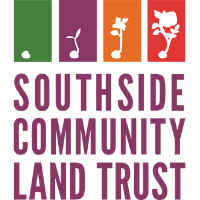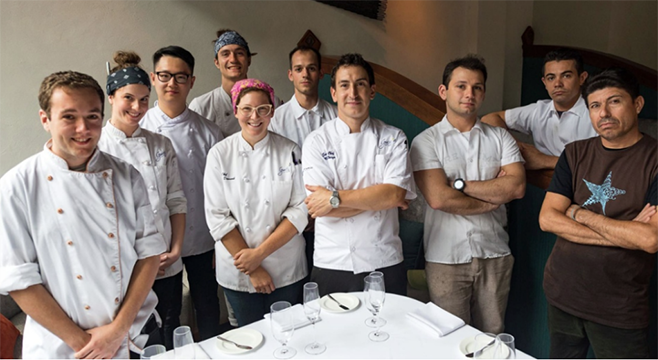This year’s Harvesting Hope fundraiser to benefit the Southside Community Land Trust (SCLT) will feature a menu designed by Gracie’s executive chef Matt Varga ’05 that will draw almost exclusively from local farmers, purveyors and brewers. The event, which takes place at the Squantum Association on Tuesday, October 3, highlights the SCLT’s work to strengthen, expand and better integrate a sustainable local food system here in Rhode Island. For Varga, an avid gardener and forager, supporting the SCLT by co-chairing and cooking at their signature event is a no-brainer: “It’s a huge honor,” he said.
Varga sources most of the produce used at Gracie’s from farmers trained by and/or growing produce on land managed by the SCLT, which was founded in 1981 and has grown to encompass a network of 52 community gardens and urban farms — 21 of which are located in Providence’s most economically challenged neighborhoods.
The goal of making fresh, healthy food accessible to all Rhode Islanders is a foundation of the SCLT’s mission; their work dovetails with a broader state initiative to build a statewide food system that “supports Rhode Island’s economy, culture and people.”
“In May 2017, Governor Raimondo released ‘Relish Rhody,’ an actionable vision for Rhode Island. It builds on the state’s momentum in growing its local food economy in a way that benefits all Rhode Islanders and affirms our commitment to increase the percentage of food consumed by Rhode Islanders that is produced in New England. Chef Varga and the Southside Community Land Trust’s work is a cornerstone of this effort,” noted Sue AnderBois, the state’s food strategy director.
With all this momentum behind catalyzing our tiny but mighty state’s potential as a leader in food planning and innovation — and serving as a model for other states to scale up their own systems — Chef Varga shares his vision for what chefs can accomplish through stewardship, advocacy and cooking with the seasons.
‘Purchasing from inside the state means that the money is staying here. It’s supporting the community that supports us.’
Tell me why it was important for you, both personally and professionally, to be involved with this year’s benefit.
When I started cooking in Rhode Island back in 2001, there was a small movement that included the SCLT, Wishing Stone Farm and a few others. Now you see farms popping up on a regular basis. People like Pat [McNiff, of Pat’s Pastured], who learned the foundation of farming at SCLT, have gone off and started their own farms. That’s a great example of what the SCLT does.
Southside and other organizations, like FarmFresh RI, are really helping to change the perception that farm-fresh food has to be a luxury.
Yes, creating that accessibility is huge with SCLT and is part of their main mission. Setting up farm stands and drop-off zones in areas where they are needed. Educating consumers on how to grow their own produce and feed their families with fresh, natural products. I think [the state] is headed in a really good direction — [we’re] proving that you really can create these farmer-chef-consumer networks.

Chef Varga working in Gracie’s rooftop garden.
Why do you make such a concerted effort to purchase local produce, meat and herbs locally?
This is important to say: We can purchase from anywhere, but purchasing from inside the state means that the money is staying here, it’s going to people that we know, it’s going to families that we know and it’s going to support local workers and local resources. It’s supporting the community that supports us, because it is full circle. We do have to look out for one another. And that’s what I love about Rhode Island so much.
How has overseeing the Gracie’s rooftop garden helped enforce your emphasis on local produce?
Working in the garden for the last 10 years has, for me, really strengthened my connection with the seasons. The garden is my best gauge for season. I know when my tomatoes are ready that everyone else’s tomatoes are going to be ready. It’s important to know what it takes to grow a radish — and knowing what too much heat or sunlight can do to them. They bolt, and you can’t use them! They get bitter.
I ran the garden for 10 years, and this is the first year I’ve passed the torch to my sous chef, Pete Kachmarsky ’11, who’s been with me for 6 years. Now he’s watching and learning and putting his own education into the growing process.
My team spends a couple of hours in the garden every day. They learn how much work goes into tilling the soil, seeding, weeding, planting and harvesting — and they don’t want to waste anything, because they know how much work it is.
JWU has a Wellness & Sustainability track for students interested in connecting with farmers, learning about the supply chain, and sourcing farm-fresh produce. What’s your advice for them?
Get your hands dirty. Go work on a farm. Learn what it takes to germinate a plant, to grow, to harvest. Learning what wild edibles are out there is also a good gauge for the seasons. There are definitely foraging groups out there. Another great way to learn is through books. I own probably two dozen books on wild edibles, foraging and specific mushroom varietals!
A whopping 40% of what we grow in the US is wasted. How do you combat waste at Gracie’s?
We’re fortunate because we have the regular tasting menu and the vegetable tasting menu. So if we do have an abundance of something, that’s an outlet for us. We have an abundance of cucumbers we don’t want to go to waste, we put them on our vegetable tasting as a cucumber salad, so we don’t lose it. So that works for us.
‘Working in the garden for the last 10 years has, for me, really strengthened my connection with the seasons.’
Bread is a product that is HUGELY wasted in the US — how can we use this leftover bread? We turn them into crisps. We make croutons. Bread crumbs. Scraps we can’t use — onion peels and carrot peels that we can’t use in our stocks — get composted. Runaway Farm picks up our produce waste once a week, and it either goes to pig feed or to compost. None of our vegetable trash goes into the waste stream.
I try to get my team members to look at products not just as products but as money. At the end of the day, this walk-in is not filled with fruits and vegetables and proteins, it’s filled with cash. It’s cold hard cash — don’t be throwing it in the trash.
When you’re using produce that’s so fresh, you don’t have to do much to it.
That’s something that I didn’t necessarily get as a young cook — I wanted to prove myself and put all I knew onto the plate.
Nowadays I really do believe that less is more, and really try to let the ingredients speak for themselves. If you spend the time and the effort to find the best of the best, you really don’t have to do that much for those ingredients to shine. And really, at the end of the day, the most memorable food experiences are the simple ones.
It’s almost primal. And then you’re focused on the experience you’re having.
That ability to share that experience is so beautiful. You can take people from totally different walks of life and bring them together around food. And that’s something that SCLT has really brought forth — creating that community based around food.
Can you give us a sneak peek at the Harvesting Hope menu…?
It’s a work in progress — a living, breathing thing. That’s just how seasonal menus work — you can get a list and feel it out, but items come and go. Will the product be available? Will it be at its peak on October 3rd? But I have a good idea of what we’re going to be doing. I think that if you stay seasonal, you can’t go wrong. I’m a firm believer in “what grows together, goes together.”
Photos by Jason Wessel
To read this article in its original form, go to JWU’s Culinary Now blog:



Post a comment